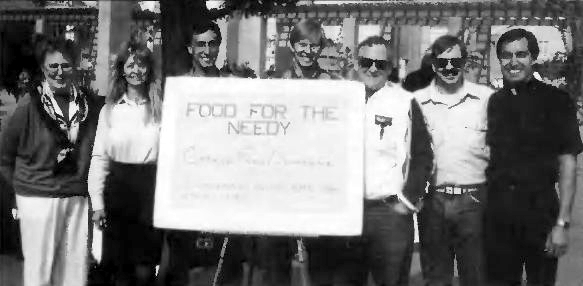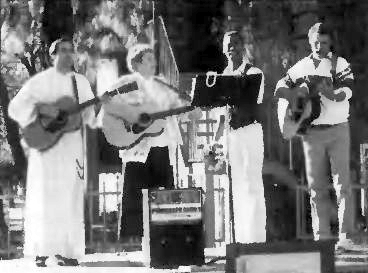![]()
The Words of the Berg Family
|
|
The Words of the Berg Family |

Staffan
Berg (fourth from the right) with other ASU campus ministers.
November 14-17, 1989 was the culmination of many months of work for the Arizona State University Campus Interfaith Council. Our theme for the week was "Unity and Diversity: A Celebration of Religious Life at ASU." My responsibility was music for the celebration, which was also the most visible activity of the week.
November 14 was the beginning of the celebration week with information table displays around the Cady Mall Fountain by the Danforth Chapel. The Church of Jesus Christ of the Latter Day Saints (Mormons), Catholics and Methodists in general never bother with information tables during the semester, but they were there for the celebration week. The Moslems are not part of the Interfaith Council and are usually somewhat distant to interfaith activities. But, this time, the Moslems showed up in force under the guidance of the local Mullah, with two large display tables, pictures of Mecca and ethnic food. It really gladdened us to see them there.
Most tables had candles, vestments for use in religious services, and other ornate ritual items displayed on their tables. The Rabbi chided us that we displayed a TV monitor and a VCR together with our literature on our book table. (Did we worship with the TV?)
Beside our table was our professional quality three-panel display stand. We exhibited some of the national projects of the Unification Movement and our locally produced leaflets. The leaflet for that week was entitled, "To Fall in Love." Many students stopped dead in their tracks at that magnetic title.
I had arranged music groups to perform outside the Danforth Chapel to draw attention to our information tables. A bagpipist of the Presbyterian/Scottish tradition initiated the program and drew a lot of attention. A Christian Rock band was only moderately popular compared with the overwhelming response we got for the Gospel choir. Definitely, the campus is hungry for some soul! Many people talked about the choir for a few days afterward.
The real day for music was Wednesday. Curiously enough, no groups other than CARP took advantage of the free music advertisement for their information tables. We enjoyed that whole afternoon of music without any real competition.
The music captured a deeply moving aspect of the central theme for the week: unity. It was summed up well by the last group performance that day: Christian Folk Music. Max Lambert of CARP sang six beautiful songs together with Rev. Richard Pyke (Presbyterian), Chaplain Debra Jennings (Episcopalian), and Father Roberto (Catholic). This is what the whole week was about: unity. The other ministers were very moved by the experience.
The same theme was expressed in a Monday forum on the topic "Created in the Image of God: What We Mean." I presented the Unificationist view after the presentations of Rabbi Barton Lee of Hillel, the Lutheran pastor Tom Petersen, and a representative of Christian Science. It was a unique opportunity of theological interchange for the ASU Interfaith Council. There had not been a similar event at ASU in ten years and the participants really enjoyed the opportunity. They found the hour-long discussion section thought-provoking.
We showed four educational videos about racism. At lunch time, Max Lambert participated as one of four minority panelists on a discussion and question/ answer session on racism.
The theme of the last day of the week was overcoming hunger. Baptist, Lutheran, Episcopalian, Jewish, Catholic and Assembly of God representatives and CARP had their tables united in a half circle around the tree in front of the Danforth Chapel. There were three significant points in this:
1. We put the tables side by side;
2. No group propagated its own cause through literature or proselytizing. All the tables were barren except for the denominational identification cloth upon which we piled cans of food and donation baskets;
3. The Campus Ministers themselves were there. On other occasions, students and other clergy manned the information tables.

An
inter-religious musical presentation attracts students to our
witnessing tables.
The issue of interfaith unity was strongly challenged. Two determined members of Campus Crusade for Christ came up and challenged our unified stance. Campus Crusade is a member organization of the Interfaith Council but chose not to get involved with any aspect of the Interfaith Celebration Week. They kept their display table far away from the others.
Two fundamentalist students charged that the participating Christian groups compromised their "Christian faith" by accepting the company of CARP and Hillel. I talked with them for a while but soon realized how futile this was, and handed it over to the Lutheran campus minister. He was aghast over this accusation and soon had involved most of the other denominations in the disagreement. They took the stance for unity and their arguments were strong and loud that overcast November day. They argued for over an hour while I asked student donations for the hungry.
Later, I assembled all for a group photo around the sign for donations for the hungry. The Jewish program director, Rikki Kanner, echoed the contentment we all felt after the busy week. She said, "This feels like a family outing."
On the fourth panel of the Interfaith Week Program, Rev. Pyke and Rikki Kanner gave mention to CARP. I felt it was the signature of the program. We played a large role in putting this whole week into action. The other campus ministries did not realize how they had carried out True Parents' direction when they helped organize and participate in this week on Unity and Diversity.
The initial difficulty we had in being recognized at the ASU Interfaith Council is now vindicated. In addition to official membership status granted to us in 1988, the three ministries which opposed us most strongly have now had to change. The rabbi of Hillel had been very negative toward the Unification Movement. He voted to table the motion of our admittance to the Council and was put in charge of an ad hoc task force to look into the Unification Church track record at ASU. At the November meeting of 1988 he represented one of the two groups who persisted in voting against our admittance to the Council.
Then he became the 1989 president of the Interfaith Council at ASU. From that position, he actually testified to and complimented the Unification Campus Minister for initiating the Interfaith Week in November.
The Newman Center, which persistently voted against our membership in the Council in 1988, publicly testified to us in 1989. I heard the priest praise the Unification Campus Minister to a dozen other campus ministers for the great idea of the Interfaith Week. (He might not have realized that the idea of campus revivals came from True Father!) I worked together with him for the music portion of the Interfaith Program during the entire fall semester. He is a wonderful man.
The most extreme group which actively propagated negative editorials concerning brainwashing is no longer part of the Campus Interfaith Council. This fundamentalist group, Campus Aglow, resigned from membership on the Council exactly one year after they attacked us. The main reason for resigning was their objection to the extensive ecumenical cooperation during the Interfaith Week!